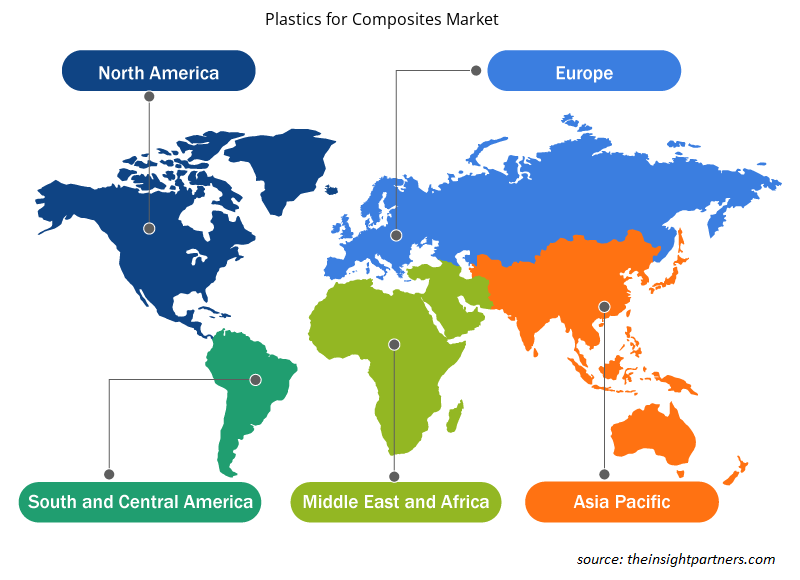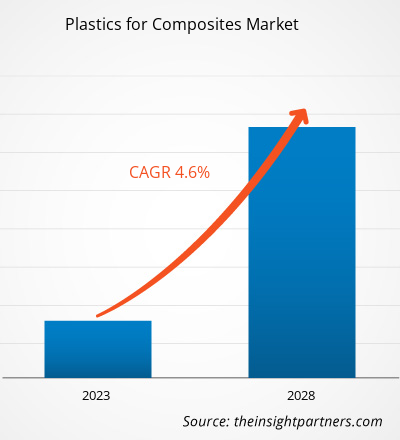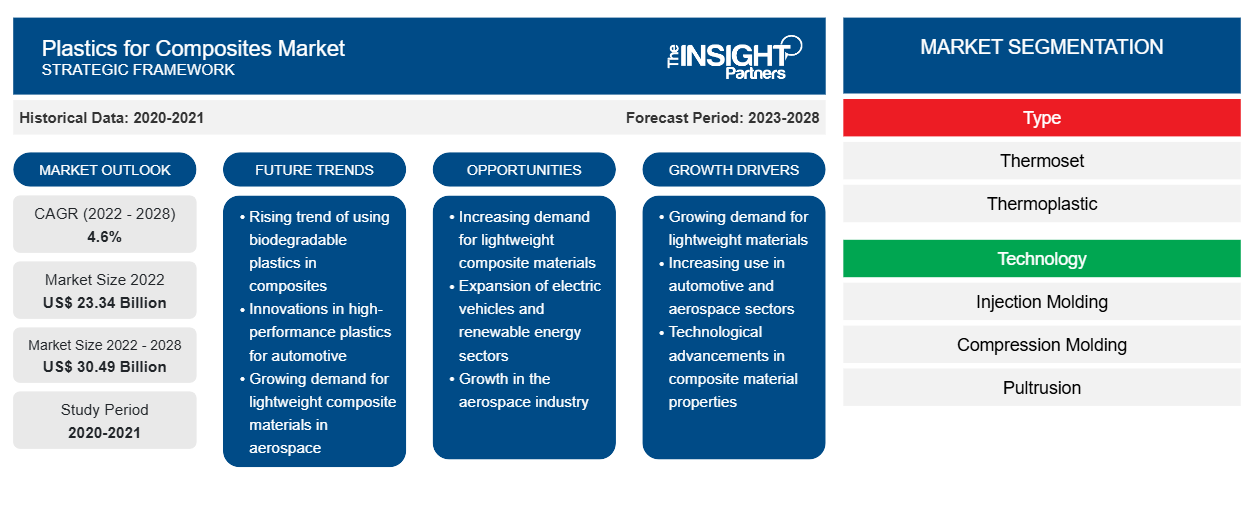Se espera que el mercado de plásticos para compuestos crezca de US$ 23.337,24 millones en 2022 a US$ 30.490,85 millones en 2028; se estima que registrará una CAGR del 4,6% entre 2022 y 2028.CAGR of 4.6% from 2022 to 2028.
Los materiales compuestos son materiales que constan de dos o más fases química y físicamente diferentes separadas por una interfaz distinta. La mayoría de los materiales compuestos producidos comercialmente utilizan un material de matriz polimérica, a menudo llamado solución de resina. Las matrices poliméricas más utilizadas incluyen poliéster, éster de vinilo, epoxi, fenólico, poliimida, poliamida, polipropileno y poliéter éter cetona (PEEK). El bajo costo, la fácil procesabilidad, la buena resistencia química y la baja gravedad específica son algunas de las principales ventajas asociadas con las matrices poliméricas.phenolic, polyimide, polyamide, polypropylene, and polyether ether ketone (PEEK). Low cost, easy processability, good chemical resistance, and low specific gravity are among the major advantages associated with polymer matrices.
La creciente adopción de resinas compuestas en las actividades de construcción y edificación, y en aplicaciones aeroespaciales y militares está contribuyendo al crecimiento del mercado de plásticos para compuestos . Además, la demanda de materiales ligeros en la fabricación de vehículos, para mejorar la eficiencia del combustible, es otro factor que impulsa la expansión del mercado. Además, la creciente demanda de resinas termoplásticas está contribuyendo significativamente al crecimiento general del mercado de plásticos para compuestos. Las fibras rígidas y una mayor resistencia al calor, resistencia al agrietamiento, alta resistencia al impacto y matriz polimérica resistente son las principales características de los compuestos poliméricos que impulsan su popularidad. Es probable que el aumento de las inversiones en la generación de energía renovable impulse la demanda de compuestos poliméricos en los próximos años.
Personalice este informe según sus necesidades
Obtendrá personalización en cualquier informe, sin cargo, incluidas partes de este informe o análisis a nivel de país, paquete de datos de Excel, así como también grandes ofertas y descuentos para empresas emergentes y universidades.
-
Obtenga las principales tendencias clave del mercado de este informe.Esta muestra GRATUITA incluirá análisis de datos, desde tendencias del mercado hasta estimaciones y pronósticos.
Perspectivas del mercado
La creciente demanda de las industrias automotriz y aeroespacial impulsa el crecimiento del mercado de plásticos para composites
La resina compuesta se utiliza en diversas aplicaciones, incluidas la construcción y la infraestructura, el transporte, la electricidad y la electrónica, la energía eólica, las tuberías y los tanques, la industria marina y la industria aeroespacial y militar. Los materiales avanzados son cruciales para aumentar la economía de combustible de los automóviles modernos al tiempo que garantizan la seguridad y el rendimiento. Dado que se necesita menos energía para acelerar objetos más ligeros que los más pesados, los materiales ligeros ofrecen un excelente potencial para aumentar la eficiencia del vehículo. Por lo tanto, la alta demanda de compuestos de la industria automotriz para la fabricación de vehículos ligeros y de bajo consumo de combustible impulsa el crecimiento del mercado de plásticos para compuestos. Las industrias de uso final en las economías emergentes, como China e India, son los principales contribuyentes a la creciente demanda de plásticos para compuestos. La creciente necesidad de materiales más ligeros para construir componentes y piezas de aviación ha sido otro factor significativo que contribuye al crecimiento del mercado de plásticos para compuestos. Los fabricantes de aeronaves están haciendo esfuerzos para ampliar las estructuras termoplásticas primarias en jets comerciales y aviones de negocios. Han sido los primeros en adoptar termoplásticos reforzados con fibras largas.
Tipo de información
Según el tipo, el mercado de plásticos para compuestos se segmenta en termoendurecibles (poliéster, éster de vinilo, epoxi, poliuretano y otros) y termoplásticos (polipropileno, polietileno, cloruro de polivinilo, poliestireno, tereftalato de polietileno, policarbonato y otros). El segmento de termoendurecibles tuvo una mayor participación del mercado en 2021. El termoendurecible es un material de matriz polimérica popular para compuestos reforzados con fibra. Los ejemplos comunes de termoendurecibles incluyen epoxis y poliésteres. Se encuentran entre los principales tipos de sistemas de matriz, utilizados específicamente en la industria aeroespacial. Los compuestos de matriz termoendurecible se utilizan más ampliamente que los compuestos de matriz termoplástica debido a su menor viscosidad a temperaturas relativamente bajas (menos de 100 °C), lo que facilita mejor el proceso de humectación de resina/fibra. Se espera que estos factores impulsen el crecimiento del mercado de componentes de matriz termoendurecible.
Entre los actores clave que operan en el mercado de plásticos para compuestos se encuentran Lanxess AG, Covestro AG, Celanese Corp, INEOS Group Holdings SA, Daicel Corp, BASF SE, Evonik Industries AG, Solvay SA, Saudi Basic Industries Corp y Arkema SA. Los principales actores adoptan estrategias como fusiones y adquisiciones, y lanzamientos de productos para expandir su presencia geográfica y su base de consumidores. Por ejemplo, en junio de 2022, Lanxess AG lanzó un compuesto con matriz de poliamida 6 a base de ciclohexano “verde”.
Perspectivas regionales del mercado de plásticos para materiales compuestos
Los analistas de Insight Partners explicaron en detalle las tendencias y los factores regionales que influyen en el mercado de plásticos para materiales compuestos durante el período de pronóstico. Esta sección también analiza los segmentos y la geografía del mercado de plásticos para materiales compuestos en América del Norte, Europa, Asia Pacífico, Oriente Medio y África, y América del Sur y Central.

- Obtenga datos regionales específicos para el mercado de plásticos para compuestos
Alcance del informe de mercado de plásticos para materiales compuestos
| Atributo del informe | Detalles |
|---|---|
| Tamaño del mercado en 2022 | US$ 23.34 mil millones |
| Tamaño del mercado en 2028 | US$ 30,49 mil millones |
| CAGR global (2022-2028) | 4,6% |
| Datos históricos | 2020-2021 |
| Período de pronóstico | 2023-2028 |
| Segmentos cubiertos |
Por tipo
|
| Regiones y países cubiertos |
América del norte
|
| Líderes del mercado y perfiles de empresas clave |
|
Densidad de los actores del mercado de plásticos para materiales compuestos: comprensión de su impacto en la dinámica empresarial
El mercado de plásticos para composites está creciendo rápidamente, impulsado por la creciente demanda de los usuarios finales debido a factores como la evolución de las preferencias de los consumidores, los avances tecnológicos y una mayor conciencia de los beneficios del producto. A medida que aumenta la demanda, las empresas amplían sus ofertas, innovan para satisfacer las necesidades de los consumidores y aprovechan las tendencias emergentes, lo que impulsa aún más el crecimiento del mercado.
La densidad de actores del mercado se refiere a la distribución de las empresas o firmas que operan dentro de un mercado o industria en particular. Indica cuántos competidores (actores del mercado) están presentes en un espacio de mercado determinado en relación con su tamaño o valor total de mercado.
Las principales empresas que operan en el mercado de plásticos para compuestos son:
- Lanxess AG
- Covestro AG
- Corporación Celanese
- Grupo INEOS Holdings SA
- Corporación Daicel
Descargo de responsabilidad : Las empresas enumeradas anteriormente no están clasificadas en ningún orden particular.

- Obtenga una descripción general de los principales actores clave del mercado de plásticos para compuestos
Informe Destacado
- Tendencias progresivas en la industria de plásticos para compuestos que ayudarán a los actores a desarrollar estrategias efectivas a largo plazo
- Estrategias de crecimiento empresarial adoptadas por las empresas para asegurar el crecimiento en los mercados desarrollados y en desarrollo
- Análisis cuantitativo del mercado mundial de plásticos para composites de 2020 a 2028
- Estimación de la demanda de plásticos para compuestos en diversas industrias
- Análisis de las cinco fuerzas de Porter para ilustrar la eficacia de los compradores y proveedores que operan en la industria de los plásticos para los compuestos
- Avances recientes para comprender el escenario competitivo del mercado y la demanda de plásticos para compuestos
- Tendencias y perspectivas del mercado y factores que rigen el crecimiento del mercado de plásticos para compuestos
- Estrategias esclarecedoras que apuntalan el interés comercial en el crecimiento del mercado, ayudando en el proceso de toma de decisiones
- Tamaño del mercado de plásticos para compuestos en varios nodos del mercado
- Descripción detallada y segmentación del mercado, así como su dinámica industrial.
- Tamaño del mercado de plásticos para compuestos en varias regiones con oportunidades de crecimiento prometedoras
El "Análisis del mercado de plásticos para composites hasta 2028" es un estudio especializado y profundo de la industria de productos químicos y materiales, centrado en el análisis de tendencias del mercado de plásticos para composites. El informe tiene como objetivo proporcionar una descripción general del mercado con una segmentación detallada. El mercado de plásticos para composites está segmentado en función del tipo, la tecnología y la geografía. Según el tipo, el mercado se segmenta en termoendurecibles (poliéster, éster de vinilo, epoxi, poliuretano y otros) y termoplásticos (polipropileno, polietileno, cloruro de polivinilo, poliestireno, tereftalato de polietileno, policarbonato y otros). Según la tecnología, el mercado se segmenta en moldeo por inyección, moldeo por compresión, pultrusión, infusión de resina y otros. En términos de geografía, el mercado está segmentado en cinco regiones principales: América del Norte, Europa, Asia Pacífico, Oriente Medio y África, y América del Sur y Central. En 2021, Asia Pacífico dominó el mercado de plásticos para composites. Se espera que la región registre la CAGR más alta del mercado durante el período de pronóstico. Las industrias automotriz y de la construcción en Asia Pacífico están creciendo a un ritmo rápido. Es la región más poblada del mundo y alberga una de las industrias de la construcción de más rápido desarrollo del mundo. Estos factores contribuyen a una alta demanda de plásticos para compuestos en Asia Pacífico.
- Análisis histórico (2 años), año base, pronóstico (7 años) con CAGR
- Análisis PEST y FODA
- Tamaño del mercado, valor/volumen: global, regional y nacional
- Industria y panorama competitivo
- Conjunto de datos de Excel
Informes recientes
Informes relacionados
Testimonios
Razón para comprar
- Toma de decisiones informada
- Comprensión de la dinámica del mercado
- Análisis competitivo
- Información sobre clientes
- Pronósticos del mercado
- Mitigación de riesgos
- Planificación estratégica
- Justificación de la inversión
- Identificación de mercados emergentes
- Mejora de las estrategias de marketing
- Impulso de la eficiencia operativa
- Alineación con las tendencias regulatorias























 Obtenga una muestra gratuita para - Mercado de plásticos para compuestos
Obtenga una muestra gratuita para - Mercado de plásticos para compuestos